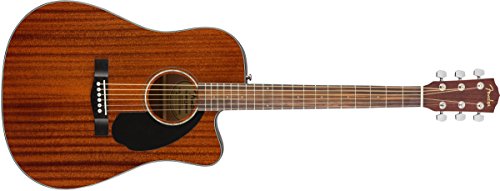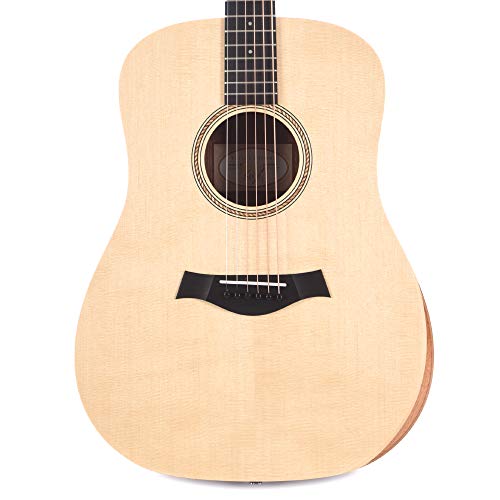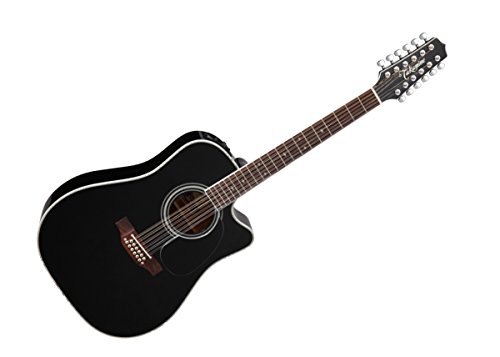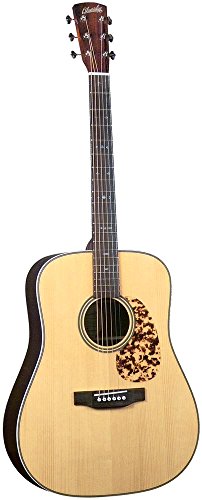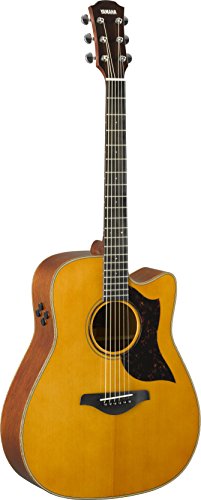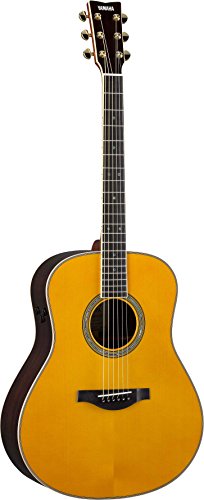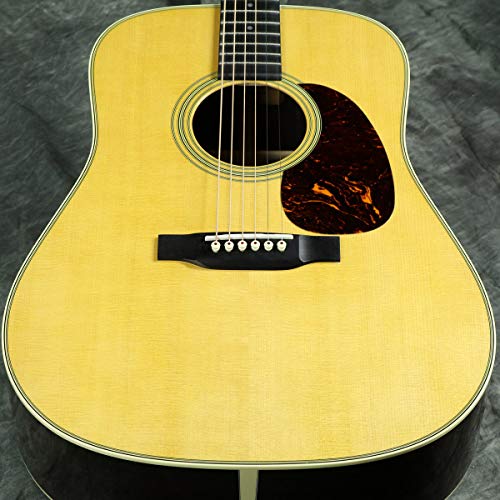Top 10 Best Dreadnought Guitar Reviews
Are you interested in learning about the best dreadnought style acoustic guitars on the market? Have you ever asked yourself what is a dreadnought guitar and how does it compare to other acoustic guitars? Are you interested in both traditional acoustic and acoustic electric guitars? Then check out this best dreadnought guitar review for the answers to all your questions!
List Of 10 Best Dreadnought Guitar Reviews
1. Martin Standard Series D-18 - Best Overall
Specifications
Top: Sitka Spruce
- Fretboard: Ebony
- Scale Length: 25.4”
- Cutaway: No Cutaway
The Martin Standard Series D-18 is the industry standard, best overall dreadnought guitar. The D-18 has been the first choice dreadnought guitar for generations of acoustic musicians because of its warm and rich tone. The Martin D-18 has a proven reputation of clarity and balance when mixed in an ensemble and Martin’s build quality and craftsmanship are legendary (1).
The Martin D-18 features a superior solid Sitka spruce topwood. A solid top means that the top of the guitar is built from one piece of wood, as opposed to multiple joined pieces. Solid tops resonate better and generally have a richer and more defined tone and project volume better than composite tops. The Sitka spruce top is joined together by mahogany sides which lend a heavier and darker timbre to the otherwise very light and ethereal sounding spruce. This blend is a common combination on dreadnought acoustic guitars.
The D-18 also features an ebony fretboard for a smooth and warm feel and sound. The D-18 only has 20 frets and does not have a cutaway which means the higher frets are more difficult to access than a guitar with a cutaway. But, the 25.4″ scale length makes for a comfortable feeling neck that is enjoyable to play.
Overall, the Martin D-18 is an iconic instrument that has been the first choice for an acoustic dreadnought guitar for generations. Its warm and clear tone have set the industry standard for decades and its construction and playability are well established. Although they have a hefty price tag, you will not be disappointed if you purchase the Martin D-18. It is one of the best acoustic guitars on the market today.
2. Fender CD-60SCE - Budget Pick
Specifications
Top: Solid Mahogany
- Fretboard: Walnut
- Scale Length: 25.3”
- Cutaway: Single Cutaway
If you are on a tighter budget, but are still looking for a high-end dreadnought acoustic guitar, you should check out the Fender CD-60SCE! Fender is no slouch when it comes to build quality and the CD-60SCE is a great example of their acoustic guitar craftsmanship (2).
The Fender CD-60SCE features an all-mahogany body. A mahogany top, sides and back brings a darker and heavier timbre than the Martin D-18’s spruce top. The CD-60SCE will not sit as clearly in a mix as the Martin, but it is close to 10% of the price. The top features a beautiful natural finish that allows the grain of the wood to shine through. The CD-60SCE also features a mahogany neck with walnut fretboard and rounded neck edges for a gentle and smooth feel.
The Fender CD-60SCE features some onboard electronics including a built-in tuner and a Fishman CD pickup/preamp system which mean you can plug in to a PA system or amplifier for louder, acoustic electric performance situations. The CD-60SCE has a single cutaway for easier access to all 20 frets and a 25.3″ scale length which is almost identical to the D-18.
Overall, the Fender CD-60SCE is a perfect choice for the intermediate guitarist looking for a quality dreadnought acoustic guitar on a budget. This Fender is certainly no D-18, but it is a great guitar for the price. The established quality of Fender craftsmanship combined with the rounded neck profile and built-in electronics make for a versatile and expandable instrument that will help you develop into a serious guitarist!
3. Taylor Academy 10 - Best Left-Handed Option
Specifications
Top: Sitka Spruce
- Fretboard: Ebony
- Scale Length: 24 ⅞”
- Cutaway: No Cutaway
The Taylor Academy 10 is the best option for that rare and awesome left-handed acoustic guitarist interested in a quality dreadnought acoustic guitar. Taylor makes high quality guitars across a wide range of price points and the Academy 10 is no exception!
The Taylor Academy 10 features a solid Sitka spruce top for clear and well defined notes and chords and great volume projection. The brightness of the Sitka spruce is balanced out by the midrange warmth of layered sapele back and sides. This combination produces a balanced acoustic timbre that will blend well in an ensemble and can stand confidently on its own as a solo instrument.
The ebony fretboard paired with the hard rock maple neck adds an equally well balanced timbre and feel to the instrument. The slightly smaller 24 ⅞” scale length and 20 frets makes for a comfortable playing guitar for smaller hands or a speedy neck for a player used to a longer scale length. The Academy 10 does not have a cutaway or any built-in electronics so you would need to add an acoustic pickup or mic to play in amplified situations.
Overall, if you are a left-handed guitarist looking for a quality dreadnought guitar, the Taylor Academy 10 lefty is a great choice. The price point is very approachable for the quality and Taylor is well established as a contemporary builder of quality guitars. The combination of woods is attractive and well balanced and finding a left-handed guitar of this quality is exceptional.
4. Takamine EF381SC 12-String - Best 12 String
Specifications
Top: Solid Spruce
- Fretboard: Rosewood
- Scale Length: 25.375″
- Cutaway: Single Cutaway
The Takamine EF381SC is the best 12 string option on this list. The EF381SC emerges from over five decades of quality craftsmanship, exploration, and experimentation at the Takamine Pro Series facility. A clear and precise sounding 12 string dreadnought is a true gem and can add a perfect layer of acoustic shimmer to your music.
The Takamine EF381SC features a solid spruce top for clear and consistent tone and projection. The back and sides are constructed from maple which brings a brighter timbre to the table than mahogany or sapele would. The brightness of the body woods is partially balanced out with a darker mahogany neck and rosewood fretboard. The EF381SC features a single cutaway, allowing easier access to all 20 frets and the 25.375″ scale length is nearly identical to the Martin D-18 and Fender CD-60SCE.
The Takamine also includes a built-in tuner, which you will find extremely useful as there are twice as many strings to tune as a normal 6 string guitar! Additionally, the EF381SC also includes Takamine’s CT4B II preamp system and unique Palathetic under-saddle pickup for exceptional amplified tone in acoustic electric situations. The CT4B II preamp system features a three-band EQ and volume control to help dial in your perfect tone.
Overall, the Takamine EF381SC is an excellent choice for a high-end dreadnought 12 string. You don’t want to waste money on a poorly built 12 string. A poorly built 12 string will prove to be a tuning nightmare and will sound like garbage. Instead, invest your money in a well built 12 string and your music will be all the better for it!
5. Takamine GD93CE-NAT
Specifications
Top: Solid Spruce
- Fretboard: Laurel
- Scale Length: 25.4”
- Cutaway: Single Cutaway
The Takamine GD93CE-NAT is a beautiful and well-built guitar at a mid-tier price range. As you saw with the EF381SC, Takamine has developed a strong reputation as a builder of quality instruments across a range of budgets. The GD93CE-NAT is comparable to the Martin D-18 for about a third of the price.
Like many of the other dreadnought guitars on this list, the Takamine GD93CE-NAT features a solid spruce top for increased clarity and projection. The GD93CE departs there and features a combination of maple and walnut sides and a unique and interesting looking 3 piece maple and walnut back. This unique combination of tonewoods gives the Takamine a special and deep resonance. The GD93CE is rounded out by a mahogany neck and bound laurel fretboard for rich tone and gentle playability.
Like its cousin the EF381SC, the GD93CE features an on board tuner and a Takamine TK-40D preamp system which includes three-band EQ and gain controls, mid contour switch, notch filter and an EQ bypass switch for a truly customizable amplified tone. The Takamine features a 25.4″ scale length which is identical to the D-18 and 21 frets with a single cutaway for improved access to its higher register.
Overall, the Takamine GD93CE is a great choice for a guitarist interested in a high-end dreadnought guitar that is well built for about a third of the price of the Martin D-18. The GD93CE features many of the same qualities that make the Martin so great, but without the high price tag.
6. Blueridge BR-160A
Specifications
Top: Solid Adirondack Spruce
- Fretboard: Santos Rosewood
- scale Length: 25.6”
- Cutaway: No Cutaway
If you are looking for a vintage sounding instrument without paying the money and worry for a true vintage guitar, the Blueridge BR-160A may be the perfect guitar for you. Blueridge guitars are mostly machine made in China and are based in pre war Martin guitars. The BR-160A design is based on the Martin D-28, which you can find further down on this list.
The Blueridge BR-160A features a solid Adirondack spruce top designed with Martin’s pre war bracing pattern for a particular vintage tone and resonance. This prewar bracing pattern is a design feature that was used in Martin guitars before World War II and generally sells for twice this price. Adirondack spruce is a more rare choice than Sitka spruce and occasionally lacks the clarity and pristine look of Sitka. If you don’t mind a few darker spots running through the top, then it won’t be a problem.
The BR-160A features Indian rosewood back and sides which pairs well with the bright Sitka top. A mahogany neck and Santos rosewood fretboard round out a well appointed guitar. The Blueridge does not feature a cutaway or any electronics, so if you are interested in performing in amplified situations you will need to purchase some additional gear.
Overall, the Blueridge BR-160A is a fine choice for a guitarist interested in a traditional design and vintage sounding dreadnought guitar that is similar to a D-28 for about half the price. A few sources on the internet cite that build quality is scattered on these guitars, so my recommendation is to try a few different BR-160As to find one that feels and plays to your specifications before purchasing one.
7. Taylor 100 Series 2017 114e Grand Auditorium
Specifications
Top: Solid Sitka Spruce
- Fretboard: Ebony
- Scale Length: 25.5”
- Cutaway: No Cutaway
The Taylor 114e Grand Auditorium is a perfect, middle-of-the-road dreadnought acoustic guitar for an intermediate to professional guitarist. The 114e is built from quality components and comes at an accessible price point for a high-end guitar.
The Taylor 114e Grand Auditorium features a standard solid Sitka spruce top and layered walnut sides for a well balanced woody timbre and pleasing looks. A hard rock maple neck combined with an ebony fretboard blend well with the body tonewoods. The 25.5″ scale length is slightly longer than the Martin D-18, but should be comfortable for the beginner and advanced guitarist alike.
The Taylor 114e also includes Taylor’s patented Expression System 2 pickup system. The Expression System 2 features three uniquely positioned and individually calibrated pickup sensors that sit behind the saddle as opposed to under it like more traditional piezo pickup systems. The thinking is that placing the pickups behind the saddle produces a more rich and louder output signal than traditional acoustic electric systems.
Overall, The Taylor 114e Grand Auditorium is a great choice for an intermediate to advanced guitarist who is looking for one of the best acoustic guitars without spending a fortune. Taylor is a builder of high-quality guitars and the 114e is no exception. Quality components combine with the Expression System 2 pickup make for a versatile and well rounded dreadnought for many situations.
8. Yamaha 6 String Series A3M
Specifications
Top: Solid Sitka Spruce
- Fingerboard: Ebony
- Scale Length: 25.5”
- Cutaway: Single Cutaway
The Yamaha 6 String Series A3M is a well-built dreadnought acoustic guitar that rivals many similar acoustics two or three times its price. Yamaha is often regarded as a budget builder of inexpensive guitars, but the A3M proves this is not exclusively the case.
The Yamaha A3M features a solid Sitka spruce top that is treated with Yamaha’s unique A.R.E. wood torrefaction, a high-heat treatment that imbues the guitar top with greater stability and an aged, vintage hue. This treatment removes moisture and impurities from the wood resulting in a product with supposedly superior sustain and clarity. The Sitka spruce top is joined by a mahogany back and sides, a common combination which results in a warm and balanced resonance.
The neck is built from three pieces of mahogany and topped with an ebony fingerboard for a gentle and responsive playability. The 25.5″ scale length is comparable to other guitars in this category. The A3M also includes Yamaha’s under the bridge SRT2 piezo pickup system which models either a Neumann KM 56 small-diaphragm condenser mic or a Royer R-122 active ribbon mic, two high quality recording microphones.
Overall, the Yamaha A3M is a comparable choice to the Taylor 114e Grand Auditorium or Takamine GD93CE-NAT. All three feature Sitka spruce tops, comparable back and side tonewoods, and well designed pickup systems. Like the Takamine, the Yamaha A3M features a single cutaway for access to the higher registers. My advice would be to try to get your hands on each of them before making a decision.
9. Yamaha L-Series Transacoustic
Specifications
Top: Solid Sitka Spruce
- Fretboard: Rosewood
- Scale Length: 25.5”
- Cutaway: No Cutaway
The Yamaha L-Series Transacoustic is a unique and creative guitar for just above $1000. The L-Series pushes the design of the dreadnought acoustic guitar into new and interesting territory because of its built-in effects like reverb and chorus and quality components.
The Yamaha L-Series Transacoustic features a solid Engelmann spruce top for superior clarity and volume. Engelmann spruce is a less common choice for a top wood than Sitka and is also known as White spruce or Silver spruce because of its lighter color. It is also less stiff than Sitka spruce, which generally allows it to resonate better with more overtones than Sitka (3). The L-Series Transacoustic also features a solid rosewood back and sides which compliments and balances out the brightness of the spruce top. A 5-ply mahogany and ebony neck make for extreme comfort and playability and an ebony fretboard round out a superbly crafted dreadnought.
However, the truly exciting aspect of the Transacoustic is the guitar’s built-in actuator installed on the inner surface of the guitar back. This device vibrates in response to the vibrations of the strings and then conveys those vibrations to the body of the guitar and to the air in and around the guitar body, generating authentic reverb and chorus sounds from inside the body without any external amplification needed. This is a truly revolutionary technology that opens many exciting creative pathways!
Overall, the Yamaha L-Series Transacoustic is perfect for a performing guitarist interested in a well-built, high-end dreadnought acoustic guitar with contemporary features. The choice of Engelmann spruce is a unique and bold decision for a dreadnought and the self-generated reverb and chorus effects could prove intriguing to the creative musician interested in pushing the boundaries of traditional acoustic guitar playing.
10. Martin 2017 D-28
Specifications
Top: Solid Sitka Spruce
- Fretboard: Ebony
- Scale Length: 25.4”
- Cutaway: No Cutaway
Like its cousin the D-18, the Martin D-28 has been a staple of folk, rock, country, and bluegrass styles for decades. The Martin brand is synonymous with quality dreadnought acoustic guitars for a reason. They have long established themselves as a premier builder of excellent instruments with a very particular and popular sound.
The D-28 features a standard solid Sitka spruce top joined by East Indian rosewood back and sides. A select hardwood neck matched with an ebony fretboard round out this iconic dreadnought. According to Martin Guitars CEO, Chris Martin (4):
We have extracted the finest features from the D-28 of both my grandfather’s and my father’s respective eras.
This seems like an accurate assessment, as this updated D-28 features classic choices in wood matched with an updated neck profile for added playability and innovative forward-shifted bracing pattern for greater resonance from the Sitka top. Like the D-18, the D-28 does not feature a cutaway, but does come with a number of options for pickups including Fishman’s Infinity Matrix and the LR Baggs Anthem pickup. Both make excellent choices if you are interested in expanding your performance capabilities.
Overall, the D-28 would be an excellent choice for a guitarist interested in owning an iconic and legendary instrument. The D-28 is an expensive instrument and carries a certain pedigree and is one of the best acoustic guitars of all time. If a Martin is what you want, then the D-28 is a great choice. But, many of the other guitars on this list compare favorably to the D-28 for half or a third of the price.
Things to Consider When Purchasing a High-end Dreadnought Guitar
Which Tonewoods are Used and How They are Constructed
It is important to consider the combination of tonewoods and their tonal qualities when purchasing a dreadnought guitar. All guitars on this list, with the exception of the Fender CD-60SCE, feature a species of spruce for a top wood. Spruce is most commonly used as a top wood for acoustic guitars because of its clear and precise timbre for single notes and strummed chords.
In general, it is a lighter and brighter sounding wood, resonates effectively, and sits well in an ensemble. Most of these guitars balance out the brightness of the spruce with some combination of mahogany, rosewood, walnut, or ebony for the back and sides. These woods are generally darker and deeper sounding than spruce and lend some weight and lower frequency response to spruce’s punchy higher frequencies.
It is also important to consider the construction of the guitar. All of these guitars are solid tops as opposed to laminated or composite tops. A solid top means that the guitar’s soundboard is built from one solid piece of wood as opposed to multiple conjoined pieces. According to guitar luthier supplier Alaska Woods (5):
Laminate tonewood isn’t as resonant as solid wood. Guitar players who truly care about the sound of their instrument– and its nuances– will seek out solid wood guitars.
Solid top guitars generally resonant stronger, have an enhanced overtone response, and sustain longer than laminate or composite top guitars. However, these guitars are generally more resource heavy and are therefore often more expensive.
To Cutaway or Not To Cutaway?
It is important to consider the question of a cutaway when purchasing a dreadnought acoustic guitar. If you are mainly interested in strumming open position chords, then having a cutaway doesn’t matter much.
Traditionally, dreadnought acoustic guitars do not feature a cutaway.
Guitars like the Martin D-18 and D-28, which essentially defined the category of dreadnought, do not feature a cutaway. Neither does the Blueridge BR-160A or the Taylor Academy 10.
However, if you are interested in pursuing single note lines and melodies and grabbing some chords higher up on the neck, then perhaps you should consider a dreadnought with a cutaway. The Taylor 114e Grand Auditorium is a bold and powerful choice for a cutaway dreadnought as is the Fender CD-60SCE if you are on a tighter budget. All of the guitars on this list with a cutaway are single cutaway. It is rare to find a double cutaway acoustic guitar.
The timbral differences between acoustic guitars with a cutaway or without are hard to pin down. There are many variables that determine an acoustic guitar’s sound including the tonewoods, the bracing construction pattern, and the body size. What makes the most sense is to choose based on your particular stylistic desires.
Any Built-In Electronics?
It is also important to consider the importance of any built-in electronics when purchasing a dreadnought guitar. What will you be using the guitar for? If you will be primarily playing in acoustic ensembles, then having a built-in pickup is not extremely valuable to you. There is a certain traditionalist philosophy as well that prefers dreadnoughts without any built-in electronics. If you fall into this camp, then a guitar like the Martin D-18 or D-28 or the Blueridge BR-160A is the perfect choice for you, as these guitars do not come with any built-in electronics.
However, if you are more interested in expanding the tonal range of the dreadnought guitar, then considering the built-in electronics may be more important to you. Many of the guitars on this list include interesting innovations to acoustic guitar pickup technology. The Yamaha L-Series Transacoustic features a unique actuator device that captures the vibrations of the strings and generates reverb and chorus effects without any exterior amplifications. The Taylor 114e Grand Auditorium includes a revolutionary pickup design where three piezo sensors are placed behind the bridge saddles, as opposed to under, which helps increase the clarity and output of the instrument.
Both the Takamine EF381SC and GD93CE-NAT feature professional level preamp and pickup systems and both systems feature a high level of control over EQ and gain functions. Of course, having a built-in tuner is also very useful for performance and practice situations and many of the guitars on this list also include one.
Additional Components like Saddle, Bridge Pins, Tuning Machines, etc.
Last, but not least, it is important to consider the quality of the guitar’s other components besides the tonewoods.
Components like the saddle, bridge pins, and tuning machines are crucial to the overall quality of the instrument.
Certainly on cheap guitars, and often on higher-end guitars as well, these smaller components are overlooked. Of course, some components like the bridge pins and tuning machines can be upgraded or replaced to fit your specifications. But other components like the saddle and nut can be more costly and tedious to replace and often require professional assistance unless you really know what you are doing.
Manufacturers like Martin and Taylor pay close attention to the quality of components such as tuning machines and saddles. Depending on the price point, other builders pay more or less attention. For example, Fender makes high-quality instruments and their higher-budget models come with great components. However, you may want to replace the bridge pins or tuning machines on the Fender CD-60SCE. The same is true of the production methods. Martin guitars are still mostly built by hand which ensures a certain amount of attention to detail. Other models, such as the Blueridge BR-160A, which is based on Martin’s design, are made mostly by machine and consequently may lack some of the close attention to detail as Martin or Taylor guitars.
FAQs
The difference between a dreadnought and a regular, or concert size, guitar is the size and shape of the body. A dreadnought style guitar features a larger back end, slim tapered waist, and comfortable front end. Dreadnoughts generally have a louder overall volume and project better than regular concert guitars and as such are often preferred for solo performances.
Yes, more expensive acoustic guitars generally sound better than cheap acoustic guitars. The idea of sounding better is subjective, but there is a reason that guitars like the D-18 or D-28 have been the industry standard for decades. The differences in tone may be inconsequential to you, but when you dive into recording, you will probably find that a more expensive guitar sounds better because it will be made from higher quality components and with more attention to detail.
Yes, dreadnought guitars are good for fingerstyle. Many famous musicians have played fingerstyle on dreadnought acoustic guitars most of their careers. Dreadnought guitars generally have excellent overall volume, projection, and tone. The most important thing is if the guitar feels right in your hands and fits your style.
References
- Dreadnought History. Retrieved from: https://www.martinguitar.com/about/martin-story/dreadnought-story/
- Fender Historical Timeline. Retrieved from: https://www.fender.com/articles/gear/fender-through-the-years-a-timeline-of-music-and-instruments
- Guitar Tonewoods Explained! Retrieved from: https://www.tfoa.eu/en/blogs/blog/tonewoods-explained/
- Martin D-28 Guitar. Retrieved from: https://www.martinguitar.com/guitars/standard-series/d-28/
- Laminate vs. Solid Wood Acoustic Guitars. Retrieved from https://alaskawoods.com/laminate-vs-solid-wood-acoustic-guitars/


